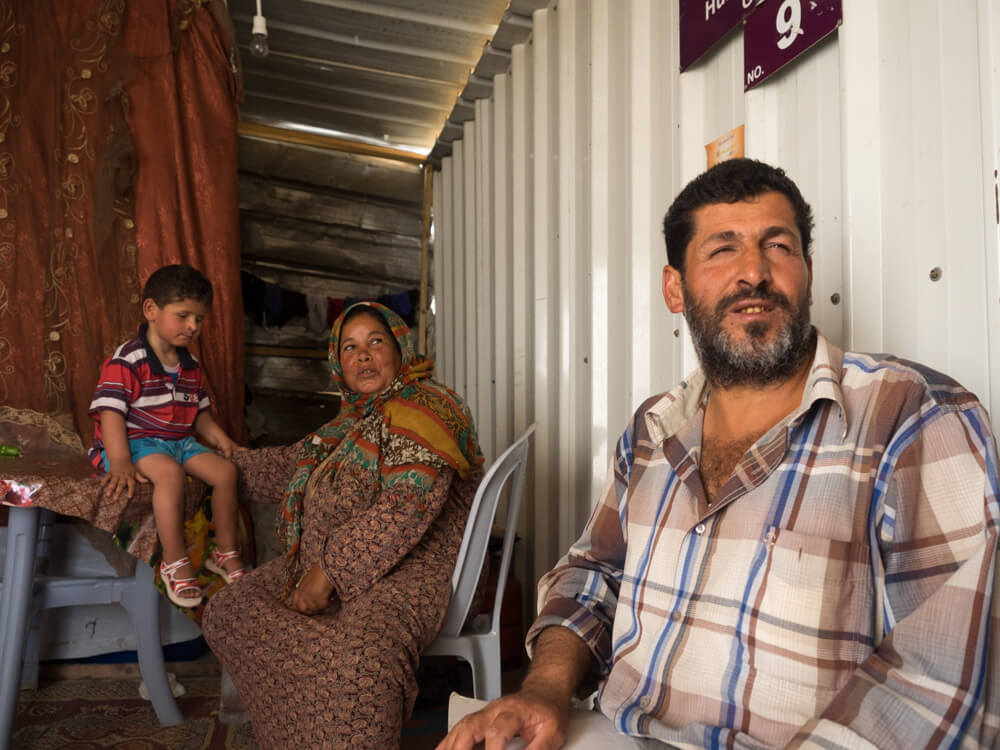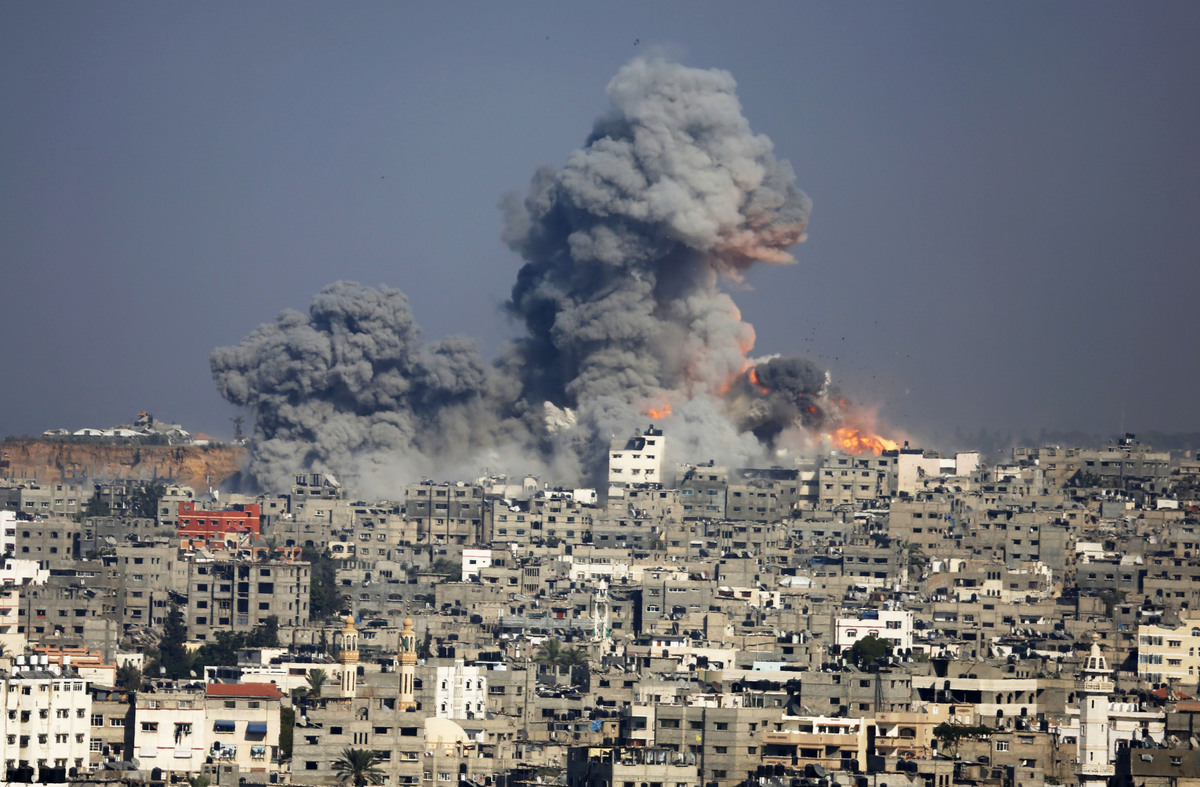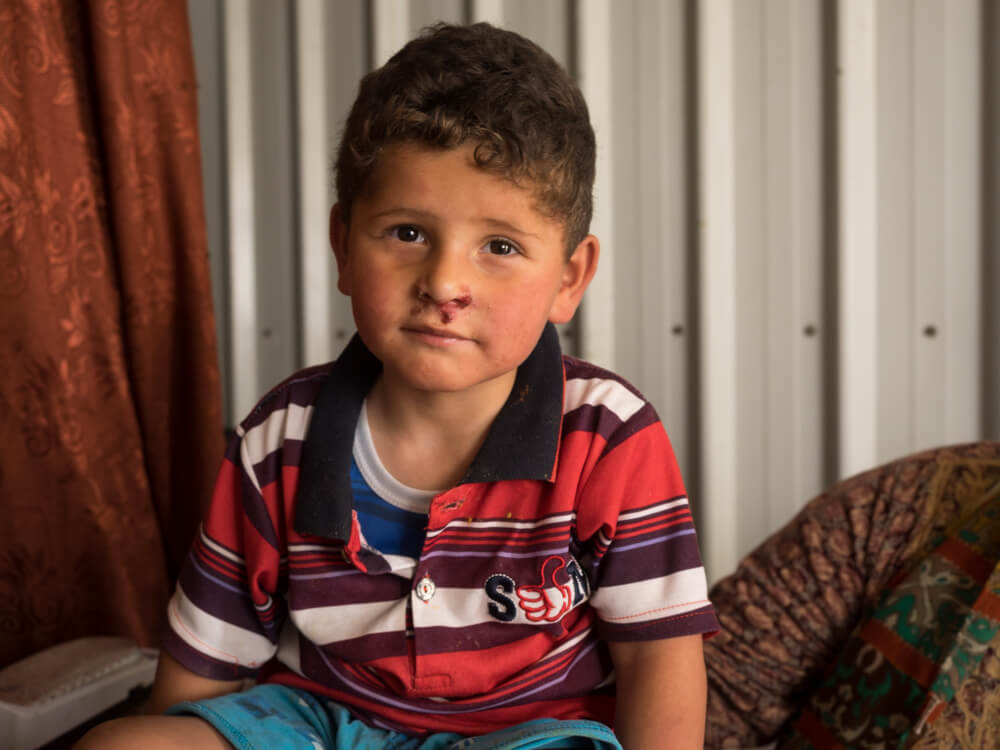Living in metal shipping containers
An extract from an OCHA report on the humanitarian needs of Palestinians in Gaza follows the Mondoweiss article.

Ahmad Najjar and his parents sit in the donated shipping container they have lived in since last autumn.
Families in Khuza’a forced to live in shipping containers as politics prevent Gaza reconstruction
Text and photos by Dan Cohen, Mondoweiss
May 11, 2015
Two-year-old Ahmad Najjar scooted on his rear end across the dirt in front of the shipping container he and his family live in the Gaza farming village of Khuza’a. Unable to walk because of a genetic condition and lacking a wheelchair, Ahmad resorts to dragging himself by his hands. His grandmother, who also can not walk and is blind, sat and wailed inside the container in sweltering heat. “I’m so hot! God help me,” she moaned while rocking back and forth. The Najjar family’s stately home in Khuza’a was one of 100,000 homes damaged or destroyed during Israel’s war on Gaza in 2014 that killed more than 2200 Palestinians, most of whom were civilians. Eight months after the final ceasefire reconstruction in Gaza has not begun, and the Najjar family is is forced to live in a donated shipping container just across the street from the four-meter-high mound of rubble that used to be their home.
Ahmad’s father Youssef Najjar, 46, mostly blind and afflicted with nerve damage, stood over his mother and broke into tears. “In this caravan, our life is all about suffering,” he sighed.
Seventy-four other families, mostly from the larger Najjar family live in the caravan as well. Makeshift pathways have been cleared through the rubble, and the biggest chunks were piled up to form a massive hill where a tent sits on top and overlooks the grey moonscape of destruction. In the distance one can see Khuza’a’s farmland and Israeli towns across the border, as well as intermittent Israeli pillboxes equipped with remote-control machine guns aiming into Khuza’a.
With their lives hanging by threads, the families living in the caravan are among the most vulnerable Palestinians in the besieged Gaza Strip. Every day is a crisis, and each season brings new difficulties which the residents are ill-equipped to confront.
I first met the Najjar family during a severe winter storm in January. The day before my visit, their container was flooded with rainwater and sewage nearly a meter high. Unable to walk, Ahmad was trapped inside and nearly drowned before being rescued. The day after my visit, heavy rains again flooded the caravans.
Throughout the winter, the uninsulated containers were iceboxes. In freezing temperatures with heavy rains and hail, families had no choice than to build fires in the containers in order to stay warm. “At night, I can’t get warm with eight blankets,” Youssef Najjar told me in January.
Now as summer approaches, the Mediterranean heat is turning the poorly ventilated containers into sweltering boxes. The caravans are unsanitary and cramped — sometimes with a dozen people per container — and makeshift additions built from wood and scrap metal have been attached. “We used to live in a big house and we suffered from the heat,” Youssef Najjar said. “But that doesn’t compare to what we live through now.”
Throughout the winter, promises of reconstruction kept a glimmer of hope among the population of the caravan. After donors gathered in Cairo and $5.4 billion was promised to rebuild Gaza, only a fraction has been allowed in as Israel, the Egyptian coup regime, and Palestinian Authority President Mahmoud Abbas have colluded to prevent delivery of construction materials. Any hope has long since evaporated and the bitter reality of the siege is now undeniable. “Rebuilding my house is a lie. I heard about reconstruction in the media. It’s all bullshit,” Najjar remarked.
Worse yet, rumours are afloat that the caravan may be evicted by the owner of the land, leaving the families with absolutely nowhere to go. “As much as I can talk about it, it’s not enough — I can’t put it into words,” Najjar told me.
Situation Report by OCHA
September 04, 2015
EXTRACT
The scale of damage resulting from the 50-day escalation in hostilities is unprecedented since the beginning of the Israeli occupation in 1967. All governorates in Gaza witnessed extensive aerial bombardment, naval shelling and artillery fire, resulting in the widespread loss of life and livelihoods. Damage to public infrastructure was also unprecedented, leaving hundreds of thousands of people without adequate services, including electricity, clean water and quality healthcare.

Destruction of Gaza’s only power plant. Photo by AP.
The Gaza Power Plant (GPP) remains inoperable following an Israeli airstrike on 29 July and despite extensive repairs, electricity outages of 18 hours a day continue in most areas across Gaza. Extensive damage to the water and wastewater system means that 20 to 30 per cent of households, or 450,000 people, remain unable to access municipal water due to damage and/or low pressure. Following the ceasefire there was a steep decline in the number of internally displaced persons, but figures have gradually risen again in UNRWA shelters, and an estimated 110,000 are still displaced, including with host families Explosive Remnants of War (ERW) are a major protection concern and pose a risk to those returning to their homes and involved in repair and reconstruction activities.
The majority of the Gaza population has lost its productive assets. According to the Palestinian Federation of Industries, 419 businesses and workshops were damaged, with 128 completely destroyed. With limited activity at the commercial crossings and extensive damage to private infrastructure and other productive assets, business activities were largely paralyzed during the operation. Hostilities forced farmers and herders to abandon their lands, and resulted in substantial direct damage to Gaza’s 17,000 hectares of croplands as well as much of its agricultural infrastructure, including greenhouses, irrigation systems, animal farms, fodder stocks and fishing boats. Access to the sea was also prohibited for most of the 50 days of hostilities; restrictions have been restored to the six nautical mile limit, but there have been reports of shooting at, and detaining, fishermen in recent days, reportedly for exceeding this limit.
These losses come on top of an already fragile economy and livelihoods. Around 66 per cent of the population of Gaza was receiving food assistance prior to the crisis and the household food insecurity level or vulnerable to food insecure stood at 72 per cent of households. Unemployment has increased dramatically since mid-2013, following a halt of the illegal tunnel trade with Egypt, soaring from 28 per cent in the third quarter (Q3) of 2013 to 45 per cent in Q2 2014; almost 70 per cent of the youth aged 20-24 were unemployed in Gaza in Q2 2014. It is expected that labour market conditions in Gaza will further deteriorate following the conflict, exacerbating the impact of the blockade and the longstanding access restrictions imposed by Israel which have been preventing any meaningful economic activity.

A few Palestinians venture out to inspect their former homes during a 12-hour cease-fire in Gaza City’s Shujaiyah neighbourhood, Saturday, July 26, 2014. Photo by Khalil Hamra / AP.
In addition to shelter solutions, the main priority for humanitarian agencies continues to be the repair and reconstruction and the restoration of essential services to affected communities, which effectively means the entire population of the Gaza Strip. However, this will not be possible without a more permanent agreement that will allow for the entry of the materials needed to re-build homes, schools and hospitals, to repair roads, electricity lines and water and sanitation networks and bring about transformational change in Gaza.
Going back to the status quo ante won’t solve the problem, it will only defer it for another day. It will not stop the bloodshed, it will make it even worse the next time the cycle rolls over the people of Gaza and plagues the people of Israel. Gaza is an open wound and Band Aids won’t help. There must be a plan after the aftermath that allows Gaza to breathe and heal.
UN Secretary General, Ban Ki-moon, 21 July.
Hostilities and casualties
The cumulative death toll among Palestinians as a result of the hostilities is at least 2,131 according to preliminary data collected by the Protection Cluster from various sources, including 379 persons who could not be yet identified or their status established. Of the initially verified cases, 1,473 are believed to be civilians, including 501 children and 257 women; 279 members of armed groups. Many fatalities involved multiple family members, with at least 142 Palestinian families having three or more members killed in the same incident, for a total of 739 fatalities. Approximately 25 Palestinians accused of collaborating with Israel have reportedly been killed in Gaza by armed groups since 21 August (not included in the fatality toll above).
According to the Palestinian Ministry of Health, as of 26 August, 11,100 Palestinians, including 3,374 children and 2,088 women and 410 elderly, have been injured. Preliminary estimates indicate that up to 1,000 of the children injured will have a permanent disability and up to 1,500 orphaned children will need sustained support from the child protection and welfare sectors.
The cumulative Israeli fatality toll is 71, of whom 66 were soldiers, one security coordinator, and four were civilians, including one child; one foreign national civilian was also killed in Israel. Dozens of other Israelis, including at least six children, were directly injured by rockets or shrapnel.
Displacement
At the height of the conflict, an estimated 485,000 people — twenty-eight per cent of the population of Gaza — were internally displaced, including in UNRWA schools designated as emergency shelters (290,000), government schools (15,000), in informal shelters such as empty buildings, churches or mosques, and with host families (170,000), representing 28 per cent of the population of Gaza. The numbers decreased during the extended period of temporary ceasefires between 11 and 19 August, but soared again to 475,000 prior to the 26 August open-ended ceasefire.
Following the ceasefire there was a dramatic decline in the number of IDPs, with the numbers in UNRWA designated shelters decreased from 289,000 to 53,000 between 26 and 27 August. However, the numbers have been climbing gradually again with some 60,812 registered in 31 UNRWA shelters as of yesterday evening – higher than the number of displaced sheltered during the peak of the ‘Cast Lead’ hostilities in December 2008/January 2009. The reason for the increase appears to be a movement from government shelters — most of which have now closed — and host families to UNRWA shelters. An estimated 50,000 are staying with host families and 700 sheltering in two government schools.
WASH
The water and wastewater situation in Gaza was already critical before the emergency, due to continued over-pumping and contamination of the coastal aquifer, and continual electricity and fuel shortages. Water and wastewater services were further hampered during the war, due to aggravations of electricity and fuel shortages and the inaccessibility of many wells, pumping stations, and other facilities within the Israeli declared buffer zone. Despite the improved access to these areas following the cessation of hostilities, services remain affected due to the damage sustained to some facilities, including the Gaza Power Plant (GPP).

One of the water wells destroyed by Operation Protective Edge, this one in northern Gaza. Photo by CMWU.
An initial Damage Assessment Report (DAR) by the Coastal Municipalities Water Utility (CMWU) indicates that 12 per cent of wells have been destroyed or damaged, particularly in Gaza City, Beit Hanoun, and Deir al Balah municipalities. Agricultural and standby wells, typically with lower water quality and no chlorination, have been used by many municipalities to supplement water supplies and replace damaged wells. The DAR further identified over 33,000 metres of damaged water and wastewater networks but the figure does not include northern Gaza, which was either inaccessible or covered with rubble at the time of the report. The DAR also indicates that five per cent of main lines, three per cent of distribution lines, and 12 per cent of household connections have been damaged. There have been complaints about water quality in Rafah and Gaza municipalities, with particular concerns about sewage entering water pipes due to damage. Wastewater treatment plants in Beit Lahiya and Gaza City are not fully functioning due to damage in the plants themselves or to pressure lines. Consequently, raw sewage is discharging directly to sea or infiltrating into sand dunes. Although solid waste is being collected in most areas, it is less frequent than usual and is gathered in temporary sites within communities rather than dumped in designated landfills.
CMWU has been actively repairing damage and addressed about 80 percent of the priority repairs, focusing on those affecting the greatest number of people. Despite this, current estimates are that 20 to 30 percent of households, or 450,000 people, remain unable to access municipal water due to damage and/or low pressure. Additionally, many of these repairs are temporary and will require longer term repair after emergency works are completed. The reduction in network pressure due to damage and power cuts are also reducing the availability of water to households, with the result that the number of pumping hours reported by municipalities does not always correspond with the hours households receive water. Additionally, households which do not have electricity and/or supplemental pumps cannot fill rooftop storage tanks when water is available.
Shelter
An estimated five per cent of the entire housing stock in Gaza is uninhabitable – 18,000 housing units have been either destroyed or severely damaged, leaving approximately 108,000 people homeless. This is in addition to the pre-crisis housing deficit of 71,000 housing units, due to people living in overcrowded or inadequate conditions.
Assessment teams from UNRWA, UNDP, and the Ministry of Public Works and Housing (MPWH) will conduct detailed damage assessment in all locations starting next week. UNRWA and UNDP teams will conduct detailed damage assessment for shelters of refugee and non-refugee families respectively. Joint teams including UNRWA, UNDP and MPWH will be formed for quality control and appeals.
Health
Gaza’s health system suffers from chronic shortages in medicine, medical supplies and equipment and there have been limited training opportunities for staff. The energy crisis and the lack of fmancial support for the Ministry of Health had negatively impacted the continuity and quality of services prior to the recent emergency.
Over the past week a number of health facilities that had been closed throughout the hostilities have re-opened and are providing services, however, suffering from the same chronic conditions as previously with regard to lack of electricity, shortage of drug supplies and equipment. As of 3 September, three out of 32 hospitals remain closed with a further three having opened with limited service capacity; 24 out of 9’7 primary health centres (PHCs) remain closed. The closure of the PHCs has resulted in the overburdening of facilities in their vicinity, causing long waiting hours and considerable strain on staff and supplies. With 50 PHCs and 17 hospitals having reported damage to their infrastructure there is urgent need to repair and reopen facilities to ensure basic services are met in all five Gaza governorates.
Education
All 474,000 children enrolled in government, UNRWA or private primary and secondary schools and 55,003 children enrolled in kindergartens, as well as 30,002 university-aged youths, have been affected by the conflict. Twenty-two schools were completely destroyed and 118 schools damaged by conflict. UNRWA has reported at least 75 damaged school buildings. Many of the higher education facilities, including the Islamic University in Gaza, have also been affected. The education sector was already overstretched prior to the crisis, suffering from a shortage of almost 200 schools, with classes running in double shifts.
The new school year was scheduled to start on 24 August, but has been postponed to 14 September. When schools open, children will face even more acute over-crowding and under-resourcing as a result of the collateral damage suffered. Priorities are ERW clearance and the rehabilitation of schools from damage sustained and because of their employment as emergency shelters for IDPs. Furniture, textbooks and learning materials will also need to be replaced. Transportation is also a concern as students and teachers may need to travel some distance to schools, due to displacement or damaged schools. Additionally, with hundreds of thousands of children in need of psychosocial support (PSS), teachers and educational staff (many of whom have also experienced acute trauma) will be stretched to provide the appropriate support required to ease children back in to school and to provide ongoing support throughout the school year.
Key humanitarian priorities:
Temporary shelter and housing solutions to IDPs: immediate and short term plans to accommodate the tens of thousands of families who were rendered homeless are urgently needed.
Sustained opening of crossings: is vital, alongside the removal of restrictions on the entry of materials for rehabilitation and reconstruction.
Explosive Remnants of War (ERW): rapid clearance of built-up areas and critical facilities, as well as awareness raising campaigns amongst the most vulnerable, are urgently needed.
Additional fuel supply: fuel is needed to operate backup generators at essential facilities, including water, sanitation and health, for longer hours.
The remainder of this OCHA report lists the needs and responses as of the end of August 2014.


